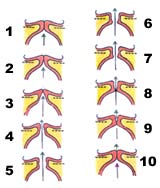vocal anatomy research
Larynx - Highly specialized structure also known as the windpipe, it is responsible for sound production, air passage during breathing and protecting the airway during swallowing.
Vocal Folds (also called Vocal Cords)
“Fold-like” soft tissue that is the main vibratory component of the voice box; comprised of a cover (epithelium and superficial lamina propria), vocal ligament (intermediate and deep lamina propria), and body (thyroarytenoid muscle).
“Fold-like” soft tissue that is the main vibratory component of the voice box; comprised of a cover (epithelium and superficial lamina propria), vocal ligament (intermediate and deep lamina propria), and body (thyroarytenoid muscle).
Glottis (also called Rima Glottidis)
Opening between the two vocal folds; the glottis opens during breathing and closes during swallowing and sound production.
Opening between the two vocal folds; the glottis opens during breathing and closes during swallowing and sound production.
How the voice works - the voice include of three different things such as;
- Voiced sound: The basic sound produced by vocal fold, vibration is called “voiced sound.” This is frequently described as a “buzzy” sound. Voiced sound for singing differs significantly from voiced sound for speech.
- Resonance: Voice sound is amplified and modified by the vocal tract resonators (the throat, mouth cavity, and nasal passages). The resonators produce a person’s recognizable voice.
- Articulation: The vocal tract articulators (the tongue, soft palate, and lips) modify the voiced sound. The articulators produce recognizable words.
Voice Mechanism
Speaking and singing involve a voice mechanism that is composed of three subsystems. Each subsystem is composed of different parts of the body and has specific roles in voice production.
Three Voice Subsystems
| Subsystem | Voice Organs | Role in Sound Production |
|---|---|---|
| Air pressure system | Diaphragm, chest muscles, ribs, abdominal muscles and Lungs | Provides and regulates air pressure to cause vocal folds to vibrate |
| Vibratory system | Voice box (larynx)Vocal folds | Vocal folds vibrate, changing air pressure to sound waves producing “voiced sound,” frequently described as a “buzzy sound”Varies pitch of sound |
| Resonating system | Vocal tract: throat (pharynx), oral cavity, nasal passages | Changes the “buzzy sound” into a person’s recognizable voice |
Key Function of the Voice Box
The key function of the voice box is to open and close the glottis (the space between the two vocal folds).
The key function of the voice box is to open and close the glottis (the space between the two vocal folds).
- Role in breathing: Open glottis
- Role in cough reflex: Close, then open glottis
- Role in swallowing: Close glottis
- Role in voice: Close glottis and adjust vocal fold tension (plus additional functions for singing)


Comments
Post a Comment